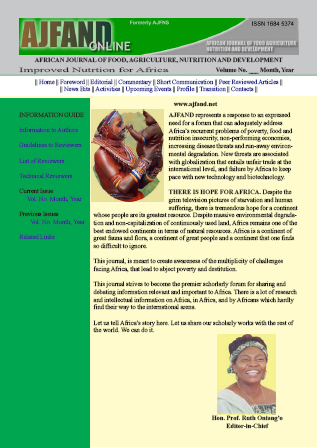
|
African Journal of Food, Agriculture, Nutrition and Development
Rural Outreach Program
ISSN: 1684-5358
EISSN: 1684-5358
Vol. 20, No. 1, 2020, pp. 15235-15251
|
 Bioline Code: nd20006
Bioline Code: nd20006
Full paper language: English
Document type: Research Article
Document available free of charge
|
|
|
African Journal of Food, Agriculture, Nutrition and Development, Vol. 20, No. 1, 2020, pp. 15235-15251
| en |
HIGH VARIABILITY OF IODINE IN IODIZED SALT AND URINE FROM RURAL HOUSEHOLDS IN SIDAMA ZONE, SOUTHERN ETHIOPIA: A CROSS-SECTIONAL STUDY
Tafere, G & Stoecker, BJ
Abstract
Iodine is essential for the synthesis of thyroid hormones which regulate the metabolic processes of most cells and play important roles in human growth and development. Iodine deficiency has long been one of the most common nutritional problems in the world. Ethiopia, particularly the study population (Sidama) has a history of severe iodine deficiency. The purpose of the study was to assess urinary iodine concentration, level of goiter in mothers and school-age children and household salt iodine concentration in households 10 months after launch of the national salt iodization program. A cross-sectional study was conducted on a randomly selected sample of women and schoolchildren. Goiter was assessed by palpation. Concentrations of iodine in salt, urine and water were analyzed by inductively coupled plasma mass spectrometry (ICP-MS). The study included 193 mothers and 76 children. The median (IQR) urinary iodine concentration (UIC) was 143 (84, 202) μg/L in the mothers and 187 (102, 278) μg/L in the children. Mothers’ UIC ranged from 17 to 767.2 μg/L and children’s UIC ranged from 19 to 739 μg/L. Goiter prevalence was high in both mothers (76%) and children (79%). The median household salt iodine concentration (SIC) was 8.1 (4.3, 13.4) ppm (mg/kg) with a range of 0 to 42 ppm. None of the water samples contained iodine above the detection limit of 1 μg/L. Despite the launch of the salt iodization program in Ethiopia, 94% of the study participants were not aware that they used iodized salt and 88% did not know the benefits of iodized salt. The major source of iodine for this population was iodized salt; however, the salt at household level contained minimal but variable amounts of iodine. Low concentration of iodine in salt may be further compounded by storage, handling and cooking techniques. The high variability of salt iodine concentration (SIC) was also reflected in the UIC of the mothers and children.
Keywords
Iodized salt; urinary iodine; goiter; children; mothers; southern Ethiopia
|
| |
© Copyright 2020 - African Journal of Food, Agriculture, Nutrition and Development
Alternative site location: http://www.ajfand.net/
|
|
